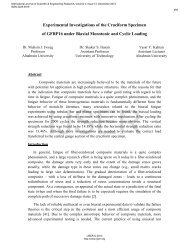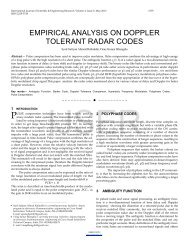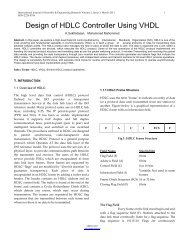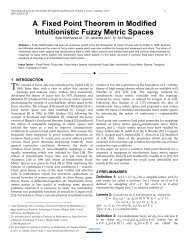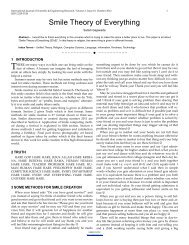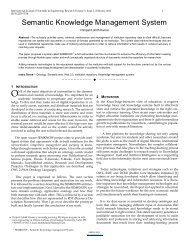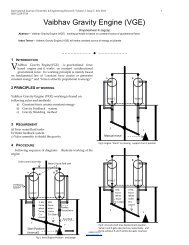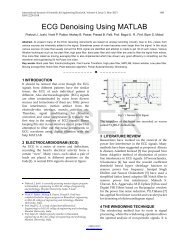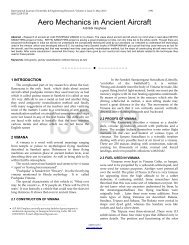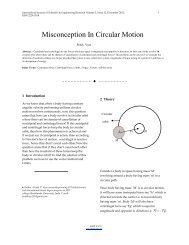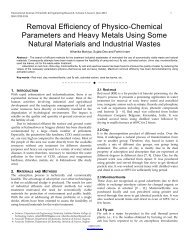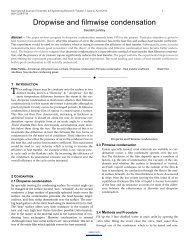Performance Study of Turbo Code with Interleaver Design
Performance Study of Turbo Code with Interleaver Design
Performance Study of Turbo Code with Interleaver Design
You also want an ePaper? Increase the reach of your titles
YUMPU automatically turns print PDFs into web optimized ePapers that Google loves.
International Journal <strong>of</strong> Scientific & Engineering Research Volume 2, Issue 7, July-2011 1<br />
ISSN 2229-5518<br />
<strong>Performance</strong> <strong>Study</strong> <strong>of</strong> <strong>Turbo</strong> <strong>Code</strong> <strong>with</strong><br />
<strong>Interleaver</strong> <strong>Design</strong><br />
Mojaiana Synthia, Md. Shipon Ali<br />
Abstract— This paper begins <strong>with</strong> an investigation <strong>of</strong> the optimization <strong>of</strong> binary turbo code through good interleaver design.<br />
For this purpose, different types <strong>of</strong> interleaver have designed here and have evaluated their performance. Basically the<br />
performances <strong>of</strong> the turbo code using block interleaver, helical interleaver, random interleaver and odd-even interleaver have<br />
evaluated. From this investigation it has been seen that for small code length the performance <strong>of</strong> the block interleaver is<br />
superior in non-puncturing case and the performance <strong>of</strong> the odd-even interleaver is superior in puncturing case, but for large<br />
code length the performance <strong>of</strong> the random interleaver is better in both <strong>of</strong> puncturing and non-puncturing condition. In this<br />
paper, it has investigated that the performance <strong>of</strong> the odd-even interleaver (block interleaver <strong>with</strong> odd number <strong>of</strong> rows and<br />
columns) significantly increased in puncturing conditions.<br />
Index terms— <strong>Turbo</strong> encoder; <strong>Turbo</strong> decoder; <strong>Interleaver</strong>; code rate; Puncturing; Nonpucturing.<br />
—————————— ——————————<br />
1. Introduction<br />
D<br />
ue to increasing demand for information exchange<br />
in modern civilization, the transfer <strong>of</strong> information<br />
from the source to its destination has to be done in such<br />
a way that the quality <strong>of</strong> the received information should<br />
be as close as possible to the quality <strong>of</strong> the transmitted<br />
information. Channel codes are used as an invaluable<br />
tool for this purpose. The channel encoder adds code<br />
bits to the transmission bit stream, based on the data bits<br />
at its input. These extra bits a reused by the channel<br />
decoder at the receiver to correct errors introduced into<br />
the transmission stream by a noisy or fading channel.<br />
But, there are two main disadvantages <strong>of</strong> error<br />
correcting codes. Firstly, the injection <strong>of</strong> extra bits into<br />
the transmission stream, thus increasing the bandwidth<br />
needed to transmit the signal. A second disadvantage is<br />
that they add complexity to the design <strong>of</strong> a<br />
communications system. In this paper some technique<br />
has introduced to overcome these problems.<br />
2. <strong>Turbo</strong> Encoder<br />
A general <strong>Turbo</strong> encoder is shown in Figure 2.1. It<br />
employs two identical systematic recursive<br />
Convolutional encoders connected in parallel <strong>with</strong> an<br />
interleaver preceding the second recursive convolutional<br />
encoder. The two recursive convolutional encoders are<br />
called the constituent encoders <strong>of</strong> the <strong>Turbo</strong> encoder.<br />
The information bits are encoded by both RSC encoders.<br />
The data frame, length <strong>of</strong> size N, inserts directly into the<br />
first encoder and after interleaving <strong>of</strong> length N, it feeds<br />
the second encoder. Therefore, N systematic bits can<br />
generate 2N parity bits and its gives a code rate <strong>of</strong> 1/3.<br />
However, it can be removed some <strong>of</strong> the parity bits in<br />
order to increase the coding rate by means <strong>of</strong> puncturing<br />
process. Furthermore, it is also possible to employ more<br />
than two component codes. However, in this paper it<br />
concentrates entirely on the standard turbo encoder<br />
structure using two RSC codes.<br />
Input Bits<br />
<strong>Interleaver</strong><br />
3. <strong>Interleaver</strong><br />
RSC Encoder 1<br />
RSC Encoder 2<br />
Puncturing<br />
Fig (2.1): General <strong>Turbo</strong> Encoder.<br />
The interleaver design is a key factor which determines<br />
the good performance <strong>of</strong> a turbo code. The output<br />
sequences <strong>of</strong> RSC encoder usually have high weight.<br />
However, some input sequences still cause the output<br />
sequence <strong>of</strong> RSC encoder to generate low weight<br />
codeword. Therefore, the interleaver scrambles the<br />
input sequence and generates randomness to the input<br />
sequence as a result high codeword can obtain. Some <strong>of</strong><br />
the useful inter-leaver used in turbo code is discussed in<br />
the following sections.<br />
A. Block <strong>Interleaver</strong><br />
Block interleaver is easy to implement in practice. This<br />
simplest interleaver is a memory in which data is written<br />
row–wise and read column–wise. It is also known as the<br />
“row–column” interleaver.<br />
X1 X2 X3 X4<br />
Output Bits<br />
IJSER © 2011<br />
http://www.ijser.org
International Journal <strong>of</strong> Scientific & Engineering Research Volume 2, Issue 7, July-2011 2<br />
ISSN 2229-5518<br />
X5 X6 X7 X8<br />
X9 X10 X11 X12<br />
X13 X14 X15 X16<br />
X17 X18 X19 X20<br />
Table (3.A.1): Writing data row–wise in memory.<br />
X1 X5 X9 X13 X17 X2 X6 .……<br />
Table (3.A.2): Reading data column–wise from memory.<br />
B. Helical <strong>Interleaver</strong><br />
A helical interleaver writes data into row–wise but reads<br />
data diagonal–wise. An example <strong>of</strong> helical interleaver is<br />
shown below:<br />
independent RSC encoders, except the systematic<br />
information only need be transmitted for one <strong>of</strong> the<br />
encoders. The decoder can reconstruct the systematic<br />
bits for the other encoders because it knows the<br />
interleaving patterns that were used. Thus, the decoder<br />
can be decomposed into T convolutional decoders <strong>with</strong><br />
each one operating on the output <strong>of</strong> a single constituent<br />
encoder. In order to get the best possible estimate <strong>of</strong> the<br />
original message, these separate decoders must be able<br />
to share the results <strong>of</strong> their calculations. To accomplish<br />
this, turbo decoders use iterative feedback decoding.<br />
Figure 4.1 shows a schematic <strong>of</strong> a turbo decoder for the<br />
classical turbo code <strong>with</strong> T=2.<br />
X1 X2 X3<br />
X4 X5 X6<br />
X7 X8 X9<br />
X10 X11 X12<br />
X13 X14 X15<br />
Table (3.B.1): Writing data row–wise in memory.<br />
X13 X11 X9 X4 X2 X15 X10 …<br />
Table (3.B.2): Reading data diagonal–wise from memory.<br />
C. Odd-Even <strong>Interleaver</strong><br />
An odd-even interleaver is a block interleaver in which<br />
the number <strong>of</strong> rows and columns must be odd numbers.<br />
D. Random <strong>Interleaver</strong><br />
The most used turbo code interleaver is the random<br />
interleaver. It basically generates a mapping between the<br />
input and the output positions. It can be designed for<br />
arbitrary length <strong>of</strong> input bits. If the length <strong>of</strong> the input is<br />
N, the mapping set will have N! combinations and<br />
chooses one combination to permute the input bits. A<br />
simple random interleaver to permute data is shown<br />
below:<br />
X1 X2 X3 X4 X5 X6 X7 X8 X9<br />
Fig (3.D.1): The random interleaver <strong>with</strong> length 10.<br />
4. <strong>Turbo</strong> Decoder<br />
Random <strong>Interleaver</strong><br />
X8 X4 X3 X9 X2 X6 X7 X1 X5<br />
In a turbo encoder <strong>with</strong> T constituent encoders, the<br />
encoder output contains a single systematic output and<br />
T parity outputs from the RSC encoders (assuming no<br />
puncturing), T – 1 <strong>of</strong> which operate on an interleaved<br />
version <strong>of</strong> original data block. Thus, the output <strong>of</strong> the<br />
turbo encoder can be viewed as the output <strong>of</strong> T<br />
×<br />
IJSER © 2011<br />
http://www.ijser.org<br />
D<br />
E<br />
M<br />
U<br />
X<br />
D<br />
E<br />
C<br />
1<br />
. . . . . . . . . .<br />
.<br />
Fig (4.1): General <strong>Turbo</strong> Decoder.<br />
This turbo decoder corresponds to the turbo encoder <strong>of</strong><br />
figure 2.1. The first decoder uses the systematic<br />
information , the output from the first constituent<br />
encoder , and a priori information from the second<br />
decoder , , to calculate s<strong>of</strong>t estimates <strong>of</strong> the original<br />
data in the block known as a log-likelihood ratio (LLRs),<br />
1. The systematic and a priori information are<br />
subtracted from 1 in order to prevent positive feedback.<br />
What is left over is the new information calculated by<br />
the first decoder , , known as the extrinsic<br />
information. This extrinsic information will be used as a<br />
priori information by the second decoder. The second<br />
decoder uses this a priori information along <strong>with</strong> the<br />
systematic information, and the output <strong>of</strong> the second<br />
constituent encoder . However, was calculated<br />
from an interleaved version <strong>of</strong> , so both the systematic<br />
information and extrinsic information from the first<br />
~<br />
decoder must be interleaved (forming and , ,<br />
respectively) before being used in the second decoder.<br />
The second decoder produces the extrinsic information<br />
, that is de-interleaved and then fed back to the first<br />
encoder to be used as a priori information , . After the<br />
first decoding cycle has completed, the decoder is not<br />
taking in new inputs. Instead, it is iterating toward a<br />
I<br />
N<br />
T<br />
INT<br />
DE-INT<br />
D<br />
E<br />
C<br />
2<br />
DE-INT
International Journal <strong>of</strong> Scientific & Engineering Research Volume 2, Issue 7, July-2011 3<br />
ISSN 2229-5518<br />
best estimate <strong>of</strong> the transmitted data using the received<br />
values that it now has stored in memory. After I<br />
iterations, the feedback loop is broken and the LLRs<br />
produced by the second decoder are de-interleaved one<br />
final time to put them in the same order as the original<br />
data block and a hard limiter makes the final bit<br />
decisions to produce the decoded block.<br />
5. Simulation Result<br />
In this paper, interleavers effects have investigated into<br />
two different conditions depend on transmission data<br />
rate. One is non-puncturing condition where all <strong>of</strong> parity<br />
bits are transmitted along systematic bits. And other is<br />
puncturing condition where some <strong>of</strong> parity bits are<br />
transmitted along systematic bits.<br />
A. Effect in Non-puncturing Case<br />
Figure 5.A.1, 5.A.2 and 5.A.3 shows the BER<br />
performance <strong>of</strong> the turbo code using random interleaver,<br />
helical interleaver and block interleaver; <strong>with</strong>in nonpuncturing<br />
situations. From figure 5.A.1, it is observed<br />
that the performance <strong>of</strong> both <strong>of</strong> the block interleaver and<br />
helical interleaver are better than the random interleaver<br />
for small code length input data. Again, it is also shown<br />
that for large code length input data the performance <strong>of</strong><br />
random interleaver is better than others as figure 5.A.3.<br />
The performance <strong>of</strong> block interleaver and helical<br />
interleaver are almost same for any code length <strong>of</strong> input<br />
data.<br />
K = 3, G0 = 7, G1 = 5; R = 1/3; Log-MAP Algorithm; 4,000 Blocks<br />
Random (40*40)<br />
Block (40*40)<br />
Helical (40*40)<br />
Bit error rate, BER<br />
Bit error rate, BER<br />
K = 3, G0 = 7, G1 = 5; R = 1/3; Log-MAP Algorithm; iterations = 8; 4,000 Blocks<br />
10 0 Random (60*60)<br />
block (60*60)<br />
Helical (60*60)<br />
10 -1<br />
10 -2<br />
10 -3<br />
10 -4<br />
10 -5<br />
0 0.5 1 1.5 2 2.5<br />
Signal-to-noise ratio, Eb/No (dB)<br />
Fig (5.B.2): BER performance <strong>with</strong> different interleavers.<br />
K = 3, G0 = 7, G1 = 5; R = 1/3; Log-MAP Algorithm; Iteration = 8; 4,000 Blocks<br />
10 0 Random (70*70)<br />
Block (70*70)<br />
Helical (70*70)<br />
10 -1<br />
10 -2<br />
10 -3<br />
10 -4<br />
10 -5<br />
0 0.5 1 1.5 2 2.5<br />
Signal-to-noise ratio, Eb/No (dB)<br />
Fig (5.A.3): BER performance <strong>with</strong> different interleavers.<br />
10 0 Signal-to-noise ratio, Eb/No (dB)<br />
K = 3, G0 = 7, G1 = 5; R = 1/2; Log-MAP Algorithm; Iteration = 8; 4,000 Blocks<br />
10 0 Signal-to-noise ratio, Eb/No (dB)<br />
Bit error rate, BER<br />
10 -1<br />
10 -2<br />
10 -3<br />
0 0.5 1 1.5 2 2.5<br />
Bit error rate, BER<br />
10 -1<br />
10 -2<br />
Random (40*40)<br />
block (40*40)<br />
Helical (40*40)<br />
Fig (5.A.1): BER performance <strong>with</strong> different interleavers.<br />
B. Effect in Puncturing Case<br />
Bit puncturing is required in order to assure the efficient<br />
use <strong>of</strong> available bandwidth. <strong>Turbo</strong> code performance<br />
using random interleaver, helical interleaver and block<br />
interleaver <strong>with</strong>in puncturing situations are shown in<br />
figure 5.B.1, 5.B.2 and 5.B.3.<br />
10 -3<br />
0 0.5 1 1.5 2 2.5<br />
Fig (5.B.1): BER performance <strong>with</strong> different interleavers.<br />
IJSER © 2011<br />
http://www.ijser.org
International Journal <strong>of</strong> Scientific & Engineering Research Volume 2, Issue 7, July-2011 4<br />
ISSN 2229-5518<br />
K = 3, G0 = 7, G1 = 5; R = 1/2; Log-MAP Algorithm; Interations = 8; 4,000 Blocks<br />
K = 3, G0 = 7, G1 = 5; R = 1/2; Log-MAP Algorithm; Iteration = 8; 5,000 Blocks<br />
10 0 Signal-to-noise ratio, Eb/No (dB)<br />
10 0 Signal-to-noise ratio, Eb/No (dB)<br />
10 -1<br />
Random (60*60)<br />
block (60*60)<br />
Helical (60*60)<br />
Random (41*41)<br />
Odd-even (41*41)<br />
Helical (41*41)<br />
Bit error rate, BER<br />
10 -2<br />
10 -3<br />
Bit error rate, BER<br />
10 -1<br />
10 -2<br />
10 -4<br />
Bit error rate, BER<br />
10 -5<br />
0 0.5 1 1.5 2 2.5<br />
10 -1<br />
10 -2<br />
10 -3<br />
Fig (5.B.2): BER performance <strong>with</strong> different interleavers.<br />
K = 3, G0 = 7, G1 = 5; R = 1/2; Log-MAP Algorithm; Iteration = 8; 4,000 Blocks<br />
Random (70*70)<br />
block (70*70)<br />
Helical (70*70)<br />
Bit error rate, BER<br />
10 -3<br />
0 0.5 1 1.5 2 2.5<br />
Fig (5.B.4): BER performance <strong>with</strong> different interleavers.<br />
K = 3, G0 = 7, G1 = 5; R = 1/2; Log-MAP Algorithm; Iteration = 8; 4,000 Blocks<br />
10 -1<br />
10 -2<br />
Random (61*61)<br />
Odd-even (61*61)<br />
Helical (61*61)<br />
10 0 Signal-to-noise ratio, Eb/No (dB)<br />
10 0 Signal-to-noise ratio, Eb/No (dB)<br />
10 -4<br />
10 -5<br />
0 0.5 1 1.5 2 2.5<br />
Fig (5.B.3): BER performance <strong>with</strong> different interleavers.<br />
From these figures it is observed that the resultant<br />
performances are almost same as that obtained in nonpuncturing<br />
conditions except that the performance <strong>of</strong><br />
helical interleaver is better than the block interleaver.<br />
In puncturing case, the performance <strong>of</strong> block<br />
interleaver significantly increased when its number <strong>of</strong><br />
rows and columns are odd (odd-even interleaver). The<br />
performances <strong>of</strong> turbo code using odd-even interleaver<br />
comparison <strong>with</strong> the helical and random interleaver are<br />
shown in figure 5.B.4, 5.B.5 and 5.B.6. Also, it is observed<br />
that the performance <strong>of</strong> odd-even interleaver is better<br />
than the helical interleaver for any code length <strong>of</strong> input<br />
data. Again, for below <strong>of</strong> (60×60) code length the oddeven<br />
interleaver’s performances are better than random<br />
interleaver. Also for large code length <strong>of</strong> input data the<br />
performance <strong>of</strong> the random interleaver is still better than<br />
others.<br />
Bit error rate, BER<br />
10 -3<br />
0 0.5 1 1.5 2 2.5<br />
Fig (5.B.5): BER performance <strong>with</strong> different interleavers.<br />
K = 3, G0 = 7, G1 = 5; R = 1/2; Log-MAP Algorithm; Iteration = 8; 5,000 Blocks<br />
10 0 Random (71*71)<br />
Odd-even (71*71)<br />
Helical (71*71)<br />
10 -1<br />
10 -2<br />
10 -3<br />
10 -4<br />
10 -5<br />
0 0.5 1 1.5 2 2.5<br />
Signal-to-noise ratio, Eb/No (dB)<br />
Fig (5.B.6): BER performance <strong>with</strong> different interleavers.<br />
IJSER © 2011<br />
http://www.ijser.org
International Journal <strong>of</strong> Scientific & Engineering Research Volume 2, Issue 7, July-2011 5<br />
ISSN 2229-5518<br />
6. Result and Conclusion<br />
In this paper, effects <strong>of</strong> interleavers have studied in<br />
details <strong>with</strong> both <strong>of</strong> the puncturing and non-puncturing<br />
case. From there it has seen that for non-puncturing case,<br />
the performance <strong>of</strong> the block interleaver and helical<br />
interleaver are almost same and better than the random<br />
interleaver at small code length data transmission. But,<br />
for large code length data transmission the random<br />
interleaver perform much better than both <strong>of</strong> the block<br />
interleaver and helical interleaver. In puncturing case,<br />
the performances <strong>of</strong> these interleaver’s are almost same<br />
as that obtained in non-puncturing conditions except<br />
that the performance <strong>of</strong> helical interleaver is better than<br />
the block interleaver. But in puncturing case, that the<br />
performances <strong>of</strong> odd-even interleaver is better than the<br />
helical interleaver. This improvement is occurred<br />
because it can only possible to transmit at least one<br />
parity bit for each systematic bit by using odd-even<br />
interleaver. However, for below <strong>of</strong> (60×60) code length<br />
the odd-even interleaver’s performances are better than<br />
the performance <strong>of</strong> random interleaver.<br />
[13] Matthew C. Valenti and Jian Sun, “Handbook <strong>of</strong> RF and<br />
Wireless Technologies,” John Wiley & Sons, New York, 2003.<br />
[14] Salma Ben Jamaa, Michel Kieffer and Pierre Duhamel, “Exact<br />
MAP Decoding <strong>of</strong> Cabac Encoded Data,” University <strong>of</strong> Paris,<br />
France.<br />
[15] George White “Optimised <strong>Turbo</strong> <strong>Code</strong>s for Wireless<br />
Channels,” Ph.D. Thesis, Department <strong>of</strong> Electronics, University <strong>of</strong><br />
York, UK, October, 2001.<br />
[16] Jinghu Chen, Marc P. C. Fossorier and Shu Lin, “Bi-directional<br />
SOVA Decoding for <strong>Turbo</strong>-codes,” Department <strong>of</strong> Electrical<br />
Engineering, University <strong>of</strong> Hawaii, USA.<br />
<br />
<br />
Author1: Mojaiana Synthia, Electronics &<br />
Communication Engineering Discipline, Khulna<br />
University, Bangladesh.<br />
Author2: Md. Shipon Ali, Grameenphone Limited,<br />
Dhaka, Bangladesh<br />
REFERENCES<br />
[1] Robert H. Morelos-Zaragoza, “The Art <strong>of</strong> Error Correcting<br />
Coding,” SONY Computer Science Laboratories Inc, Japan, 2002.<br />
[2] Jason R. Hess, “Implementation <strong>of</strong> a <strong>Turbo</strong> Decoder on a<br />
Configurable Computing Platform,” Virginia Polytechnic Institute<br />
and State University, USA, 1999.<br />
[3] Alain Glavieux, “Channel Coding in Communication networks<br />
From Theory to <strong>Turbo</strong> codes,” ISTE Ltd, USA, 2007.<br />
[4] T. E. Hunter,” <strong>Code</strong>d Cooperation: A New Framework for User<br />
Cooperation in Wireless Networks,” Ph.D. dissertation, The<br />
University <strong>of</strong> Texas at Dallas, May, 2004.<br />
[5] C. Berrou, A. Glavieux, and P. Thitimajshima, “Near Shannon<br />
Limit Error- correcting Coding and Decoding: <strong>Turbo</strong>-<strong>Code</strong>s,” the<br />
International Conference on Communications, (Geneva,<br />
Switzerland), pp.1064 in1070, May, 1993.<br />
[6] S. Le Go, A. Glavieux, and C. Berrou, “<strong>Turbo</strong>-<strong>Code</strong>s and High<br />
Spectral Efficiency Modulation,” Proceedings <strong>of</strong> IEEE international<br />
conference on communications, New Orleans, LA. pp. 645-649,<br />
May 1-5, 1994.<br />
[7] Joachim Hagenauer, “Iterative Decoding <strong>of</strong> Binary Block and<br />
Convolutional <strong>Code</strong>s,” IEEE Transactions on Information Theory,<br />
Vol. 42, No. 2, March 1996.<br />
[8] Mark Bingeman, “Symbol-Based <strong>Turbo</strong> <strong>Code</strong>s for Wireless<br />
Communications,” Electrical and Computer Engineering<br />
Discipline, Waterloo, Ontario, Canada, 2002.<br />
[9] K. V. Ravi and Tam Soh Khum, “<strong>Performance</strong> <strong>of</strong> <strong>Turbo</strong> TCM in<br />
Wideband CDMA Applications,” Department <strong>of</strong> Electrical<br />
Engineering, National University <strong>of</strong> Singapore, 2000.<br />
[10] D. Gnaedig, E. Boutillon and M. Jezequel “<strong>Design</strong> <strong>of</strong> Three-<br />
Dimensional Multiple Slice <strong>Turbo</strong> <strong>Code</strong>s,” EURASIP Journal on<br />
Applied Signal Processing, 2005.<br />
[11] Fu-hua Huang, “Iterative <strong>Turbo</strong> <strong>Code</strong>. Decoder” John Wiley &<br />
Sons, New York, 2000.<br />
[12] Bernard Sklar, “Digital Communications: Fundamentals and<br />
Applications,” Second Edition, 2001.<br />
IJSER © 2011<br />
http://www.ijser.org



